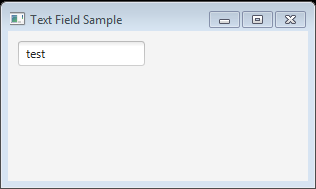JavaFX教程 – JavaFX 文本字段
TextField用于单行文本输入。
import javafx.application.Application;
import javafx.geometry.Insets;
import javafx.scene.Group;
import javafx.scene.Scene;
import javafx.scene.control.Label;
import javafx.scene.control.TextField;
import javafx.scene.layout.GridPane;
import javafx.stage.Stage;
public class Main extends Application {
public static void main(String[] args) {
launch(args);
}
@Override
public void start(Stage stage) {
Scene scene = new Scene(new Group(), 450, 250);
TextField notification = new TextField ();
notification.setText("Label");
notification.clear();
GridPane grid = new GridPane();
grid.setVgap(4);
grid.setHgap(10);
grid.setPadding(new Insets(5, 5, 5, 5));
grid.add(new Label("To: "), 0, 0);
grid.add(notification, 1, 0);
Group root = (Group) scene.getRoot();
root.getChildren().add(grid);
stage.setScene(scene);
stage.show();
}
}
TextField和PasswordField扩展了TextInput类,它是JavaFX中所有文本控件的超类。
上面的代码生成以下结果。

创建文本字段
我们可以使用TextField类的构造函数来创建文本字段。
TextField只是一个带有光标的文本输入框,通常我们需要一个Label控件来告诉文本字段的目的。以下代码创建一个Label控件以标记对应的文本字段是用于名称输入。然后它创建一个TextField对象。之后,它使用HBox布局Label和TextField。
Label label1 = new Label("Name:");
TextField textField = new TextField ();
HBox hb = new HBox();
hb.getChildren().addAll(label1, textField);
hb.setSpacing(10);
使用预定义文本创建文本域
TextField textField = new TextField("w3cschool.cn")
TextField中的文本
要从文本字段获取值,请调用getText方法。
从TextInput的setPrefColumnCount方法设置文本字段的大小。通过设置一次可以显示的最大字符数。
我们可以使用提示字幕通知用户文本字段的用途。setPromptText方法定义显示在文本字段中的字符串。无法通过getText方法获取提示文本。
以下代码显示如何设置TextField的提示文本
import javafx.application.Application;
import javafx.geometry.Insets;
import javafx.scene.Group;
import javafx.scene.Scene;
import javafx.scene.control.TextField;
import javafx.scene.layout.GridPane;
import javafx.stage.Stage;
public class Main extends Application {
@Override
public void start(Stage stage) {
Group root = new Group();
Scene scene = new Scene(root, 300, 150);
stage.setScene(scene);
stage.setTitle("Text Field Sample");
GridPane grid = new GridPane();
grid.setPadding(new Insets(10, 10, 10, 10));
grid.setVgap(5);
grid.setHgap(5);
scene.setRoot(grid);
final TextField name = new TextField();
name.setPromptText("Enter your first name.");
name.setPrefColumnCount(10);
name.getText();
GridPane.setConstraints(name, 0, 0);
grid.getChildren().add(name);
stage.show();
}
public static void main(String[] args) {
launch(args);
}
}
以下列表有一些有用的方法,我们可以使用它们在文本字段中进行文本编辑。
- copy() – 将所选文本设置为剪贴板。
- cut() – 将所选文本设置为剪贴板并删除当前选择。
- selectAll() – 选择文本输入中的所有文本。
- paste() – 将剪贴板中的内容设置为此文本并替换当前选择
上面的代码生成以下结果。

例子
以下代码显示如何将字符串值从TextField绑定到Stage Title。
import javafx.application.Application;
import javafx.beans.property.SimpleStringProperty;
import javafx.beans.property.StringProperty;
import javafx.scene.Scene;
import javafx.scene.control.Label;
import javafx.scene.control.TextField;
import javafx.scene.layout.HBox;
import javafx.stage.Stage;
public class Main extends Application {
StringProperty title = new SimpleStringProperty();
public static void main(String[] args) {
Application.launch(args);
}
@Override
public void start(Stage stage) {
TextField titleTextField;
titleTextField = new TextField();
titleTextField.setText("Stage Coach");
titleTextField.setPrefColumnCount(15);
HBox hBox = new HBox();
hBox.setSpacing(10);
hBox.getChildren().add(new Label("title:"));
hBox.getChildren().add(titleTextField);
Scene scene = new Scene(hBox,270,270);
title.bind(titleTextField.textProperty());
stage.setScene(scene);
stage.titleProperty().bind(title);
stage.show();
}
}
上面的代码生成以下结果。

例2
以下代码显示了如何将ContextMenu添加到TextField。
import javafx.application.Application;
import javafx.event.ActionEvent;
import javafx.event.EventHandler;
import javafx.geometry.Insets;
import javafx.scene.Group;
import javafx.scene.Scene;
import javafx.scene.control.ContextMenu;
import javafx.scene.control.Label;
import javafx.scene.control.MenuItem;
import javafx.scene.control.TextField;
import javafx.scene.layout.GridPane;
import javafx.stage.Stage;
import javafx.stage.WindowEvent;
public class Main extends Application {
public static void main(String[] args) {
launch(args);
}
@Override
public void start(Stage stage) {
Scene scene = new Scene(new Group(), 450, 250);
TextField notification = new TextField();
final ContextMenu contextMenu = new ContextMenu();
contextMenu.setOnShowing(new EventHandler<WindowEvent>() {
public void handle(WindowEvent e) {
System.out.println("showing");
}
});
contextMenu.setOnShown(new EventHandler<WindowEvent>() {
public void handle(WindowEvent e) {
System.out.println("shown");
}
});
MenuItem item1 = new MenuItem("About");
item1.setOnAction(new EventHandler<ActionEvent>() {
public void handle(ActionEvent e) {
System.out.println("About");
}
});
MenuItem item2 = new MenuItem("Preferences");
item2.setOnAction(new EventHandler<ActionEvent>() {
public void handle(ActionEvent e) {
System.out.println("Preferences");
}
});
contextMenu.getItems().addAll(item1, item2);
notification.setContextMenu(contextMenu);
GridPane grid = new GridPane();
grid.setVgap(4);
grid.setHgap(10);
grid.setPadding(new Insets(5, 5, 5, 5));
grid.add(new Label("To: "), 0, 0);
grid.add(notification, 1, 0);
Group root = (Group) scene.getRoot();
root.getChildren().add(grid);
stage.setScene(scene);
stage.show();
}
}
上面的代码生成以下结果。

例3
覆盖replaceText和replaceSelection以创建自定义的TextField
import javafx.application.Application;
import javafx.scene.Group;
import javafx.scene.Scene;
import javafx.scene.control.TextField;
import javafx.scene.paint.Color;
import javafx.stage.Stage;
public class Main extends Application {
public static void main(String[] args) {
Application.launch(args);
}
@Override
public void start(Stage primaryStage) {
Group root = new Group();
Scene scene = new Scene(root, 300, 250, Color.WHITE);
TextField field = new TextField() {
@Override
public void replaceText(int start, int end, String text) {
if (!text.matches("[a-z]")) {
super.replaceText(start, end, text);
}
}
@Override
public void replaceSelection(String text) {
if (!text.matches("[a-z]")) {
super.replaceSelection(text);
}
}
};
root.getChildren().add(field);
primaryStage.setScene(scene);
primaryStage.show();
}
}
上面的代码生成以下结果。


 国外主机测评 - 国外VPS,国外服务器,国外云服务器,测评及优惠码
国外主机测评 - 国外VPS,国外服务器,国外云服务器,测评及优惠码














